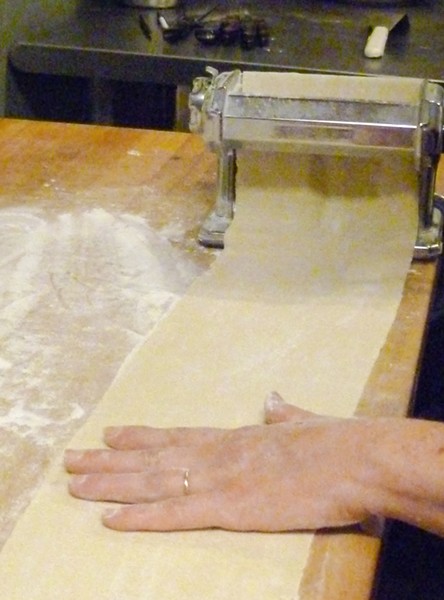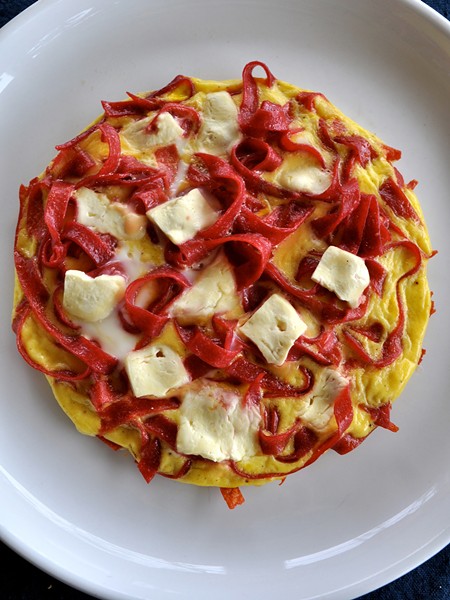When I watch Patricia Cambianica's hands kneading, shaping and cutting pasta dough, I feel her hands are my hands too. And when I work at those tasks, I feel that my hands are also the hands of generations of women who have been bringing their personal touch to this timeless craft. There is joy every step of the way, from where the adventure begins, the mixing of the ingredients into a dough, to tasting the pasta dish, where it ends. Simple tagliatelle al burro e parmigiano (with butter and Parmigiano-Reggiano cheese) and complex lasagne alla bolognese start at the same place with a pasta dough that contains eggs, giving it a pale golden color.
Some people find making pasta intimidating. The solution, however, is simple: Make a small amount of dough, half of a recipe perhaps, and give yourself and your hands time to get acquainted with the new task. Also, do not try your hand at making pasta when you are under time pressure. Anxiety has a tendency to make the small hill of dough look like a mountain.
If you are thinking that, being Italian, I surely learned to make pasta on my mother's knee, let me disabuse you of your romantic notion. My mother was an egg pasta wizard, but preferred to keep the kitchen, her kingdom, free of apprentices. I learned to make pasta as an adult by experimenting on my own, with some help from my memory, as snippets of preparation I glimpsed in my mother's kitchen are recorded in my brain. Some reading and a few online videos helped direct my experiments. I started with egg pasta dough and moved on to eggless dough, which is used to make, for example, orecchiette (I will talk more about eggless pasta in some future column).
Patricia learned to make pasta from her family. "I grew up making pasta by feel, that's the key to pasta: Once you feel how it is supposed to come out, it becomes second nature." After you master tagliatelle, you move on to more complex undertakings, like lasagne or ravioli. Or your creativity can follow a colorful direction to make green or pink pasta, with, respectively, spinach or red beets added to make the dough (see the recipe on this page).
Patricia, like my mother, describes pasta amounts not in terms of weight but in terms of how many eggs are used to make the dough. Every Sunday morning, my mother would make quattro uova di pasta, four eggs of pasta dough, more than enough for that day's lunch for our family of four. She kneaded, rolled and cut it by hand.
Working in the kitchen of her restaurant, La Trattoria, Patricia gets the dough started in a stand-up mixer. When eggs and flour have come together to form a shaggy dough, she empties the mixer bowl onto the wooden table. The wisdom of her hands takes it from there.
"I like being completely not rushed, completely there for the pasta, and you kind of get into a rhythm and you relax and you feel the pasta," she said. "It's kind of a little meditative for me. It really makes you calm down and focus."
Patricia has a small hand-cranked pasta machine, made in Italy by Imperia. As she turns the handle with her right hand, her left hand gently but firmly accompanies the wide strip of dough on its journey away from the rollers. The wisdom that comes from mindful repetition is once again on display. Physical contact with the dough breeds intimacy, the visceral knowledge of what feels right. Such intimacy allows the hands to know when the dough is of the right consistency, when the pasta is of the right thickness, when a bit more flouring is needed. In Patricia's words: "with pasta, it's all in the feel."
When I spoke with Patricia about people's fear of making pasta, her advice was identical to mine: start with a small amount, "a couple of eggs. Do it once or twice a week and just get the feel for the pasta." Once your hands become intimate with the dough, how it feels to the touch, how it stretches, how it yields to pressure and resists to it, how your fingers glide over or stick to it, how it lives to be shaped according to your ability and mood, you'll understand why I say that making pasta by hand is joyful.
La Trattoria serves dinner Thursdays through Sundays 5:30 to 9 p.m. 30 Sunnybrae Center in Arcata, (707) 822-6101 for reservations.
Pasta Dough with Roasted Red Beet
Inspired by the recipe for farfalle rosa (pink bow ties) in Pasta fatta in casa (Homemade Pasta) by Paola Loaldi
Ingredients:
- A small red beet (3 oz.)
- 1 egg
- 1 cup all-purpose flour
- 2 Tablespoons semolina flour
- Pinch of salt
Cut greens off an inch or so above the surface of the beet. Wrap in foil and roast in a 375 degree oven until tender. Unwrap, cool slightly, and slip the skin off.
(In the interest of energy efficiency, I recommend oven-roasting a bunch of beets: You can use the other beets in many ways, make a salad or a frittata - see "Not So Messy," Table Talk June 17, 2010.)
Chop beet roughly in a food processor. Add the egg to the processor bowl and process some more to create a creamy combination, then add that to combined flours and salt. Add a bit of water or more flour, as needed, to obtain a supple dough.
Wrap the dough and let it rest for half and hour or so, then roll and shape as preferred. I usually use it to make tagliatelle.


Comments